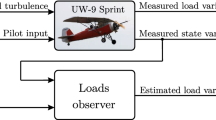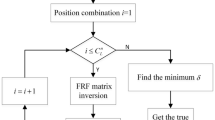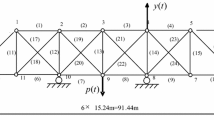Abstract
A series of work for distributed dynamic load identification is investigated in this paper considering unknown-but-bounded uncertainties in the aircraft structure. To facilitate the analysis, the complicated rudder structure is simplified to a plate structure based on the robust equivalence principle of mechanical property under multi-cases of flight environments. Aiming at the plate structure, a time domain–based model for distributed dynamic load identification is established through the acceleration response measured by sensors. Among them, the spatial distributed load is approximated by Chebyshev orthogonal polynomials at each sampling time, and load boundaries can be calculated by the Taylor-expansion-based uncertain propagation analysis. As keys to improve the reliability of recognition results, the optimization process for sensor placement is constructed by the particle swarm optimization algorithm, taking the robustness evaluation index and sensor distribution index into consideration. The validity and the feasibility of the proposed methodology are demonstrated by several numerical examples, and the results reveal that designer can make a rational tradeoff choice among the cost of sensor placement and the performance of load identification in a systematic framework.

















Similar content being viewed by others
References
Al-Kandari AM, El-Naggar KM (2003) Time domain modeling and identification of nonlinear loads using discrete time-filtering estimator, Transmission & Distribution Conference & Exposition.
Aucejo M, De Smet O (2018a) A space-frequency multiplicative regularization for force reconstruction problems. Mech Syst Signal Process 104:1–18
Aucejo M, De Smet O (2018b) On a full Bayesian inference for force reconstruction problems. Mech Syst Signal Process 104:36–59
Aucejo M, De Smet O, Deü JF (2019) On a space-time regularization for force reconstruction problems. Mech Syst Signal Process 118:549–567
Barbaro PV, Cataliotti A, Cosentino V, Nuccio S (2007) A novel approach based on nonactive power for the identification of disturbing loads in power systems. IEEE Trans Power Delivery 22:1782–1789
Batou A, Soize C (2009) Identification of stochastic loads applied to a non-linear dynamical system using an uncertain computational model and experimental responses. Comput Mech 43:559–571
Berger KT, Greene FA, Kimmel R, Alba C, Johnson H (2009) Aerothermodynamic testing and boundary-layer trip sizing of the HIFiRE flight 1 vehicle. J Spacecr Rocket 46:473–480
Bouleimen K, Lecocq H (2003) A new efficient simulated annealing algorithm for the resource-constrained project scheduling problem and its multiple mode version. Eur J Oper Res 149:268–281
Carn CL (2006) The inverse determination of aerodynamic loading from structural response data using neural networks. Inverse Prob Sci Eng 14:379–395
Carne TG, Dohrmann CR (1994) A modal test design strategy for model correlation. Proc SPIE Int Soc Opt Eng 2460:927
Chang HH, Lin LS, Chen NM, Lee WJ (2013) Particle-swarm-optimization-based nonintrusive demand monitoring and load identification in smart meters. IEEE Trans Ind Appl 49:2229–2236
Cherng AP (2003) Optimal sensor placement for modal parameter identification using signal subspace correlation techniques. Mech Syst Signal Process 17:361–378
Choi HG, Thite AN, Thompson DJ (2007) Comparison of methods for parameter selection in Tikhonov regularization with application to inverse force determination. J Sound Vib 304:894–917
Chu LC, Qu N (1991) Dynamic load identification in time domain. China Ocean Eng:279–286
Eberhart RC, Shi YH (2002) Particle swarm optimization: developments, applications and resourses, Congress on Evolutionary Computation.
Gaul L, Hurlebaus S (1998) Identification of the impact location on a plate using wavelets. Mech Syst Signal Process 12:783–795
Ghanem R, Romeo F (2000) A wavelet-based approach for the identification of linear time-varying dynamical systems. J Sound Vib 234:555–576
Hollandsworth PE, Busby HR (1989) Impact force identification using the general inverse technique. Int J Impact Eng 8:315–322
Jaddu H, Vlach M (2014) Closed form solution of nonlinear-quadratic optimal control problem by state-control parameterization using Chebyshev Polynomials. Int J Comput Appl 91:1–7
James GH, Carne TG, Mayes RL (1996) Modal parameter extraction from large operating structures using ambient excitation, Office of Scientific & Technical Information Technical Reports.
Kammer DC (1992) Effects of noise on sensor placement for on-orbit modal identification of large space structures, Aiaa/asme/asce/ahs/asc Structures, Structural Dynamics, & Materials Conference.
Kammer DC, Li Y (1994) Enhancement of on-orbit modal identification of large space structures through sensor placement. J Sound Vib 171:119–139
Latiff NA, Tsimenidis CC, Sharif BS (2007) Energy-aware clustering for wireless sensor networks using particle swarm optimization, 2007 IEEE 18th International Symposium on Personal, Indoor and Mobile Radio Communications, IEEE, 1-5.
Law SS, Bu JQ, Zhu XQ (2005) Time-varying wind load identification from structural responses. Eng Struct 27:1586–1598
Li DS, Li HN, Fritzen CP (2007) The connection between effective independence and modal kinetic energy methods for sensor placement. J Sound Vib 305:945–955
Li K, Liu J, Han X, Sun XS, Jiang C (2015) A novel approach for distributed dynamic load reconstruction by space–time domain decoupling. J Sound Vib 348:137–148
Li K, Liu J, Han X, Jiang C, Qin HJ (2016a) Identification of oil-film coefficients for a rotor-journal bearing system based on equivalent load reconstruction. Tribol Int 104:285–293
Li K, Liu J, Han X, Jiang C, Zhang DQ (2016b) Distributed dynamic load identification based on shape function method and polynomial selection technique. Inverse Prob Sci Eng 25:1–20
Lin JH, Guo XL, Zhi H, Howson WP, Williams FW (2001) Computer simulation of structural random loading identification. Comput Struct 79:375–387
Liu J, Han X, Jiang C, Ning HM, Bai YC (2011) Dynamic load identification for uncertain structures based on interval analysis and regularization method. Int J Comput Methods 8:667–683
Liu J, Sun XS, Han X, Jiang C, Yu DJ (2015) Dynamic load identification for stochastic structures based on Gegenbauer polynomial approximation and regularization method. Mech Syst Signal Process 56-57:35–54
Liu J, Meng XH, Xu C, Zhang DQ, Jiang C (2018) Forward and inverse structural uncertainty propagations under stochastic variables with arbitrary probability distributions. Comput Methods Appl Mech Eng 342:287–320
Maulik U, Bandyopadhyay S (2000) Genetic algorithm-based clustering technique. Pattern Recogn 33:1455–1465
Meo M, Zumpano G (2005) On the optimal sensor placement techniques for a bridge structure. Eng Struct 27:1488–1497
Omkar SN, Nagabhushanam J (1998) Neural network controller for minimizing hub shear forces in helicopter, Intelligent Control, .
Orlando C, Alaimo A (2017) A robust active control system for shimmy damping in the presence of free play and uncertainties. Mech Syst Signal Process 84:551–569
Papadopoulos M, Garcia E (1998) Sensor placement methodologies for dynamic testing. AIAA J 36:256–263
Patton JB, Ilic J (2002) Identification of static distribution load parameters using general regression neural networks, Symposium on Circuits & Systems.
Qiu ZP, Elishakoff I (1998) Antioptimization of structures with large uncertain-but-non-random parameters via interval analysis. Comput Methods Appl Mech Eng 152:361–372
Rao PC, Jana PK, Banka H (2017) A particle swarm optimization based energy efficient cluster head selection algorithm for wireless sensor networks. Wirel Netw 23:2005–2020
Ronasi H, Johansson H, Larsson F (2011) A numerical framework for load identification and regularization with application to rolling disc problem. Comput Struct 89:38–47
Roy D, Dash MK (2002) A stochastic Newmark method for engineering dynamical systems. J Sound Vib 249:83–100
Sanchez J, Benaroya H (2017) Asymptotic approximation method of force reconstruction: proof of concept. Mech Syst Signal Process 92:39–63
Shi YH, Eberhart RC (1998) Parameter selection in particle swarm optimization, International Conference on Evolutionary Programming VII.
Wang X, Wang S, Ma JJ (2007) An improved co-evolutionary particle swarm optimization for wireless sensor networks with dynamic deployment. Sensors 7:354–370
Wang L, Wang XJ, Li X (2016) Inverse system method for dynamic loads identification via noisy measured dynamic responses. Eng Comput 33:1070–1094
Wang L, Wang XJ, Su H, Lin GP (2017) Reliability estimation of fatigue crack growth prediction via limited measured data. Int J Mech Sci 121:44–57
Wang L, Wang XJ, Yang YW, Li YL, Chang XN (2018a) Active force control of structure-borne sound based on robust optimization subjected to an irregular cavity with uncertainties. Aerosp Sci Technol 73:318–331
Wang L, Xiong C, Wang XJ, Li YL, Xu MH (2018b) Hybrid time-variant reliability estimation for active control structures under aleatory and epistemic uncertainties. J Sound Vib 419:469–492
Wang L, Xiong C, Wang XJ, Xu MH, Li YL (2018c) A dimension-wise method and its improvement for multidisciplinary interval uncertainty analysis. Appl Math Model 59:680–695
Wang L, Liu YR, Liu YS (2019a) An inverse method for distributed dynamic load identification of structures with interval uncertainties. Adv Eng Softw 131:77–89
Wang L, Wang XJ, Li YL, Hu JX (2019b) A non-probabilistic time-variant reliable control method for structural vibration suppression problems with interval uncertainties. Mech Syst Signal Process 115:301–322
Xiong C, Wang L, Liu GH, Shi QH (2019) An iterative dimension-by-dimension method for structural interval response prediction with multidimensional uncertain variables. Aerosp Sci Technol 86:572–581
Yang C (2018) Sensor placement for structural health monitoring using hybrid optimization algorithm based on sensor distribution index and FE grids. Struct Control Health Monit 25:e2160
Zhang CD, Xu YL (2016) Optimal multi-type sensor placement for response and excitation reconstruction. J Sound Vib 360:112–128
Acknowledgments
The authors wish to express their many thanks to the reviewers for their useful and constructive comments.
Funding
The authors would like to thank the Pre-research Field Foundation of Equipment Development Department of China (61402100103), the Aeronautical Science Foundation of China (2017ZA51012, 20182951014), and the Defense Industrial Technology Development Program (JCKY2016204B101, JCKY2017208B001), the Science and Technology Foundation of China Aerospace Science and Industrial Corporation and the College Union Innovation Foundation of China Academy of Launch Vehicle Technology (CALT201704) for the financial supports.
Author information
Authors and Affiliations
Corresponding author
Ethics declarations
Conflict of interest
On behalf of the authors, the corresponding author states that there is no conflict of interest.
Additional information
Responsible Editor: Pingfeng Wang
Publisher’s Note
Springer Nature remains neutral with regard to jurisdictional claims in published maps and institutional affiliations.
Appendices
Appendix 1
In view of the nominal value of the honeycomb equivalent model \( {E}_x^c=3.2\mathrm{MPa} \), \( {E}_y^c=3.2\mathrm{MPa} \), \( {E}_z^c=6043.3\mathrm{MPa} \), \( {\mu}_{xy}^c=0.9986 \), \( {\mu}_{yz}^c=1.2427\times {10}^{-4} \), \( {\mu}_{xz}^c=1.2421\times {10}^{-4} \), \( {G}_{xy}^c=1.9\mathrm{MPa} \), \( {G}_{yz}^c=1654.2\mathrm{MPa} \), \( {G}_{xz}^c=827.1\mathrm{MPa} \), and ρc = 0.2438g/cm3, the displacement vector \( {\mathbf{u}}_i^c \) can be obtained by CFD calculation for the i-th load condition. To get the boundaries of the displacements, the sensitivity analysis is introduced, in which the perturbation of each parameter will be operate. Taking the parameter Ex as an example, the displacement vector \( {\left.{\mathbf{u}}_i\right|}_{E_x={E}_x^c+\delta {E}_x} \) can also be calculated when the Ex has the small perturbation δEx and other parameters remain unchanged. Employing the difference technique, the sensitivity of displacement vector ui with respect to parameter Ex can be expressed as \( \frac{\partial {\mathrm{u}}_i}{\partial {E}_x}=\frac{{\mathrm{u}}_i\left|{}_{E_x={E}_x^c+\delta {E}_x}-{\mathrm{u}}_i^c\right.}{\delta {E}_x} \). As shown in Fig. 18 , the upper bound \( {\overline{\mathbf{u}}}_i \) and lower bound \( {\underset{\_}{\mathbf{u}}}_i \) of displacement vector ui can be obtained through the approximate linearization which is often used in engineering. Therefore, the boundaries of displacement vector ui considering the uncertainties of each parameter can be eventually given by
and
Appendix 2
According to (15), the recurrence formulas of modal force can be concluded through displacement, velocity, acceleration, or the combination of them. However, the acceleration response is more convenient to acquire through acceleration sensors in comparison with displacement, velocity, strain, or other indexes in practical engineer.
In general, the input of measured acceleration response \( \ddot{\mathbf{w}}\left({t}_k,{\varGamma}_{\gamma}\right) \) is depend on the number and position of the sensors, therefore the modal acceleration term \( {\ddot{q}}_r\left(\boldsymbol{\upalpha}, {t}_k\right) \) is a variable related to the sensor placement, namely
where Γγ is the variable of the sensor placement.
Assume that the initial values of modal displacement response q(t0) and modal velocity response \( \dot{\mathbf{q}}\left({t}_0\right) \) are zero. Numerical integration method, such as Newmark-Beta method (Roy and Dash 2002), serve to solve the modal velocity and modal displacement response,
where the value of parameters θ and β need to be chosen according to the accuracy and stability of the integration. The parameter θ is generally taken as 0 ∼ 1/4, and β is often taken as 1/2.
Rights and permissions
About this article
Cite this article
Wang, L., Liu, Y. A novel method of distributed dynamic load identification for aircraft structure considering multi-source uncertainties. Struct Multidisc Optim 61, 1929–1952 (2020). https://doi.org/10.1007/s00158-019-02448-8
Received:
Revised:
Accepted:
Published:
Issue Date:
DOI: https://doi.org/10.1007/s00158-019-02448-8







